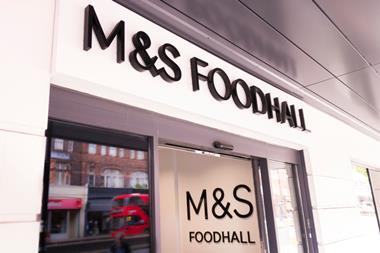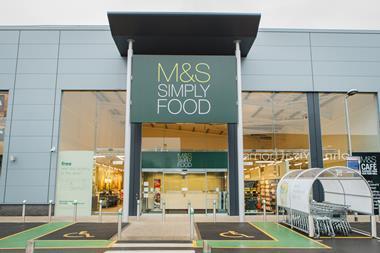Marks and Spencer shareholders may have thought that the Food business could be relied on to deliver the goods, while management got on with the task of turning around Clothing.
But now the Food operation is under pressure as well.
So what’s gone wrong with M&S Food and, as the grocery industry becomes ever more competitive, can it be turned around?
Chief executive Steve Rowe openly admitted today, with the final results, that the performance of the M&S Food business had been disappointing over the past year, with both like-for-like sales and gross margins under pressure.
Total Food sales increased by nearly 4% in 2017/18, but like-for-likes were down by 0.3%, despite the benefit of an early Easter and the return of food price inflation to the supermarket industry. And fourth quarter Food like-for-like sales were down by as much as 2.3% on an Easter adjusted basis.
Like-for-likes fell despite the investment of 150 bps of gross margin last year in improving price competitiveness.
Nevertheless, many supermarkets would die to have gross margins as high as 31% and M&S Food still accounted for 46% of total UK gross profits in year ending March (and 61% of total UK sales).
Now, it’s easy to forget that the M&S Food business was run by Steve Rowe himself between 2012 and 2015 and back then it all seemed pretty easy: the task was just to open lots of new Food only stores, to make the unique M&S offer more available to more consumers, and keep the lead that M&S had in product innovation.
The space race
There are now more than 700 M&S Simply Food stores in the UK (on top of all the Food Halls in the mainline stores) and it’s hard to move around London without seeing one of the its units at railway stations or BP petrol stations or in the high street.
M&S food may still be the first choice for a royal wedding-inspired picnic or barbecue, but M&S Food has become ubiquitous as a result of the space race of recent years and it’s hard not to feel that there must be some cannibalisation of existing outlets starting to take place.
And M&S must feel the same because a year ago it was confidently predicting the opening of at least 90 new Simply Food stores in 2017/18, but ended up only opening 62, as it began to limit its expansion to only “the highest returning locations”.
And in yesterday’s update on store closures, M&S announced that 15 fewer owned Simply Food stores will open this year, as the programme is scaled back, so that year end Food selling space will be no more than flat (given the increasing closure of small/old mainline high street stores and their Food halls).
Gross margin pressure
So, the space race in M&S Food looks to be over, but gross margin pressure is not – they are expected to be down this year by up to a further 50bps, despite the savings that can be made in packaging (did you know that the bottle that M&S uses for its prosecco costs 19p more than the competition?) and in the supply chain.
Inevitably, the management of the M&S Food business has been changed, with Archie Norman’s former protégé Stuart Machin brought in last month to shake things up and he is leading an urgent series of range reviews to try to get the price architecture right: we are now told that product development has become too “niche” and needs to be more “relevant” and that, apart from the key value item products, M&S Food prices are simply too high.
Cutting prices is not rocket science and cutting more waste should not be impossible either, but M&S will need to be careful not to lose its reputation for interesting innovation in new products and make sure that product availability does not suffer. And it will need to find a way to convince the consumer that M&S quality and provenance is worth paying for (as it has tried to do recently with its campaign on the traceability of its beef).
Of course, M&S is not the only Food business trying to get the balance right between promoting quality and “ripping people off”, but as Aldi and Lidl get bigger and bigger more and more consumers can see that quality fresh food doesn’t need to be expensive. And the ready meals and sandwiches range in Tesco and Sainsbury’s improves all the time and is readily available in their local/convenience stores.
So the world is not standing still waiting for M&S to get its Food business right (or its Clothing business, come to think of it) and these are dangerous times, with consumers tightening their belts and seeking ever more convenient ways of shopping.
Online grocery shopping is unlikely to be the answer for M&S, however, given its low basket size in Food and the fact that most of its ranges are bought for immediate purchase.
In summary, the M&S Food business has got too bloated, as a result of over-expansion, and, although management should be able to stabilise its performance, M&S shareholders may have to get used to seeing it make lower returns.
- Nick Bubb is a founding member of the KPMG/Ipsos Retail Think Tank


























No comments yet